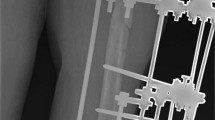Abstract
The Taylor spatial frame uses the slow correction principles of the Ilizarov system but adds a six-axis deformity analysis incorporated within a computer program. To evaluate its use in our community, we used it in lengthening and deformity correction of the lower limbs to treat 22 cases from 1999 to 2001. There were 14 females and eight males (average age 16.5 years). Our target was lengthening in eight cases, correction of deformities in eight and both in six. The results were excellent in 18 cases, good in two, and fair in two. Despite the cost, patient profile and a steep learning curve, our results were encouraging but less favorable than with the Ilizarov external fixator.
Résumé
Le Cadre Spatial de Taylor utilise les principes de la correction progressive du système Ilizarov mais ajoute une analyse de la difformité selon six axes, incorporée dans un programme informatique. Pour évaluer son usage nous l’avons utilisé dans notre institution, dans 22 cas, de 99 à 2001 pour allonger et corriger des déformations des membres inférieurs. Il y avait 14 femmes et 8 hommes (âge moyen 16.5 années). Notre but était l› allongement dans 8 cas, la correction de difformités dans 8 cas, et les deux dans 6 cas. Les résultats étaient excellents dans 18 cas, bon dans 2, et juste dans 2. En dépit du coût, du profil des patients, et de la courbe d’apprentissage, nos résultats étaient encourageant, mais moins favorables qu’avec le fixateur externe d’Ilizarov.

Similar content being viewed by others
References
Cattaneo R, Catagni M, Johnson EE (1992) The treatment of infected nonunions and segmental defects of the tibia by the methods of Ilizarov. Clin Orthop 280:143–152
Coogan PG, Fox JA, Fitch RD (1996) Treatment of adolescent Blount disease with circular external fixation device and distraction osteogenesis. J Pediatr Orthop 16:450–454
Feldman DS, Madan SS, Koval KJ, van Bosse HJ, Bazzi J, Lehman WB (2003) Correction of tibia vara with six-axis deformity analysis and the Taylor Spatial Frame. J Pediatr Orthop 23(3): 387–91. PMID: 12724607
Feldman DS, Shin SS, Madan S, Koval KJ (2003) Correction of tibial malunion and nonunion with six-axis analysis deformity correction using the Taylor Spatial Frame. J Orthop Trauma 17(8): 549–54. PMID: 14504575
Henderson RC, Kemp GJ, Greene WB (1992) Adolescent tibia vara: alternatives for operative treatment. J Bone Joint Surg Am 74:342–350
Ilizarov GA (1992) Transosseous osteosynthesis. Springer, Berlin Heidelberg New York, pp 287–543
Langenskoild A (1981) Tibia vara, osteochondrosis deformans tibiae. Blount disease. Clin Orthop 158:77–82
Monticelli G, Spinelli R (1984) A new method of treating the advanced stages of tibia vara Blount disease. Ital J Orthop Traumatol 10:295–303
Paley D (2002) Radiographic assessment of lower limb deformities. In: Paley D, ed. Principles of Deformity Correction. Springer, Berlin Heidelberg New York, pp 31–60
Pinkowski JL, Weiner DS (1995) Complication in proximal tibial osteotomies in children with presentation of technique. J Pediatr Orthop 15:307–312
Price CT, Scott DS, Greenberg DA (1995) Dynamic axial external fixation in the surgical treatment of tibia vara. J Pediatr Orthop 15:236–243
Rodl R, Leidinger B, Bohm A, Winkelmann W (2003) Correction of deformities with conventional and hexapod frames--comparison of methods. Z Orthop Ihre Grenzgeb 141(1): 92–8. PMID: 12605337
Rozbruch SR, Helfet DL, Blyakher A. (2002) Distraction of hypertrophic non-union of tibia with deformity using Ilizarov/Taylor Spatial Frame: reportof two cases. Arch Orthop Trauma Surg; 122:295–298. PMID: 12070651
Saleh M, Royston S (1996) Management of nonunion of fractures by distraction with correction of angulation and shortening. J Bone Joint Surg Br 78:105–109
Schatz KD, Nehrer S, Dorotka R, Kotz R (2002) 3D-navigated high energy shock wave therapy and axis correction after failed distraction treatment of congenital tibial pseudarthrosis. Orthopade 31:663–666
Seide K, Wolter D, Kortmann HR (1999) Fracture reduction and deformity correction with hexapod Ilizarov fixator. Clin Orthop 363:186–195
Shevtsov VI, Maer VI (1980) Ambulatory treatment of children with Erlacher-Blount disease by Ilizarov’s transosseous osteosynthesis. Orthop Traumatol 1:53–55
Sluga M, Pfeiffer M, Kotz R, Nehrer S. (2003) Lower limb deformities in children: two-stage correction using the Taylor spatial frame. J Pediatr Orthop B 12(2): 123–8. PMID: 12584497
Steel HH, Sandrow RE, Sullivan PH (1971) complication of tibial osteotomy in children for genu varum or valgum. J Bone Joint Surg Am 53:1629–1635
Taylor JC (2000) Correction of general deformity with Taylor Spatial Frame. www.jcharlestaylor.com. Accessed October 25
Taylor JC (2002) Six-axis deformity analysis and correction. In: Paley D, ed. Principles of Deformity Correction. Springer, Berlin Heidelberg New York, pp 411–436
Tetsworth KD, Paley D (1994) Accuracy of correction of complex lower extremity deformities by the Ilizarov method. Clin Orthop; 301:102–110.
Tucker H, Kendra JC, Kinnebrew TE (1992) Management of unstable open and closed tibial fractures using the Ilizarov method. Clin orthop 280:125–135
Author information
Authors and Affiliations
Corresponding author
Rights and permissions
About this article
Cite this article
Fadel, M., Hosny, G. The Taylor spatial frame for deformity correction in the lower limbs. International Orthopaedics (SICOT) 29, 125–129 (2005). https://doi.org/10.1007/s00264-004-0611-9
Received:
Accepted:
Published:
Issue Date:
DOI: https://doi.org/10.1007/s00264-004-0611-9




